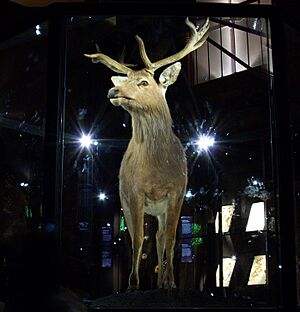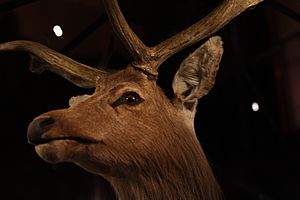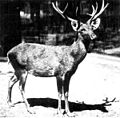Schomburgk's deer facts for kids
Quick facts for kids Schomburgk's deer |
|
|---|---|
 |
|
| Specimen in Berlin Zoo, 1911 | |
| Conservation status | |
| Scientific classification | |
| Kingdom: | |
| Phylum: | |
| Class: | |
| Order: | |
| Family: | |
| Subfamily: |
Cervinae
|
| Genus: |
Rucervus
|
| Species: |
†R. schomburgki
|
| Binomial name | |
| †Rucervus schomburgki Blyth, 1863
|
|
The Schomburgk's deer (Rucervus schomburgki) was a type of deer. It lived in central Thailand. A scientist named Edward Blyth first described this deer in 1863. He named it after Sir Robert H. Schomburgk. Sir Robert was a British official in Bangkok at that time. Sadly, this deer is believed to have died out by 1938. However, some people wonder if a few might still exist.
Contents
What Did Schomburgk's Deer Look Like?
This deer was a very graceful animal. It looked a lot like another type of deer called the barasingha. Its fur was dark brown, but its belly was lighter. The underside of its tail was white.
Male Schomburgk's deer had unique antlers. They looked like baskets because all the main points branched out. This meant their antlers could have up to 33 points! The outer edge of their antlers could be as long as 89 centimeters (35 inches). Female deer did not have antlers at all.
Where Did Schomburgk's Deer Live?
Schomburgk's deer lived in wet, flat areas in central Thailand. These areas had tall grass, reeds, and bushes. They especially liked the Chao Phraya River valley, which is near Bangkok. These deer did not like very thick forests.
They lived in groups, usually with one adult male, a few females, and their young. During the rainy season, the land would flood. This forced the deer herds to gather on higher ground, which often became like islands. This made them very easy targets for hunters.
Why Did Schomburgk's Deer Disappear?
In the late 1800s, Thailand started growing a lot of rice to sell to other countries. This led to most of the deer's natural home, like grasslands and swamps, being destroyed. People also hunted the deer a lot. This combination of losing their homes and being overhunted caused the species to die out.
Scientists believe the last wild Schomburgk's deer died around 1932 because of too much hunting. The very last deer known to be alive, which was in a zoo, died in 1938. The IUCN Red List of Threatened Species officially listed this deer as extinct in 2006. However, some scientists still think it might be alive somewhere.
Today, there is only one known stuffed Schomburgk's deer left. You can see it in a museum in Paris. This deer lived in the Paris zoo until 1868.
Could Schomburgk's Deer Still Exist?
In 1991, some antlers were found in a shop in Laos that sold traditional Chinese medicine. A United Nations expert named Laurent Chazée took a photo of these antlers. He later said they looked like they came from a Schomburgk's deer. This discovery made some people hope that the deer might not be completely gone.
Images for kids
See also
 In Spanish: Ciervo de Schomburgk para niños
In Spanish: Ciervo de Schomburgk para niños





